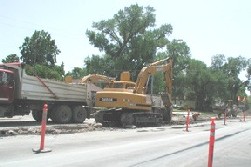Water Supply Main Replacement on 900 West Street
Water utility construction costs are increasing much faster than the rate of inflation
LeRoy W. Hooton, Jr.
June 4, 2003
|
Originally laid in 1949, the main has experienced numerous breaks, prompting its replacement. In 1949, the main was installed at a cost of $72,992 at a unit cost of $11.61 per foot. The unit cost of the current project is $196.77, reflecting today's cost of business, including reconnecting service lines, reconnecting existing distribution watermains at each intersection, asphalt costs and environmental and safety regulations.
The project is part of Salt Lake City's capital improvements program to replace its service area's aging utility infrastructure, with a focus on watermain replacements. Beginning in FY 97-98, the Department of Public Utilities was funded to replace at least 0.6 percent of the water distribution system annually. The replacement goal was determined by data collected by the American Water Works Association Water Industry Data Base (WIBD). WIBD indicates that the national average watermain replacement rate was 0.6 percent per year for both public and private, and small and large systems. This level of replacement was adopted as a beginning point for the replacement program.
At the end of this fiscal year over 347,000 lineal feet of pipe (65.8 miles) has been replaced within Salt Lake City's service area. In FY 2002-03, Public Utilities recommended to the City Council that the replacement rate be increased to 1.0 percent. Proposed water rate increases are included in Public Utilities Business Plan to meet this new level of investment. Although the recommendation and future rate increases are included in the plan, the actual funding appropriations are approved on a year to year basis by the Mayor and City Council.
Despite the emphasis on replacing aging watermains, the number of watermain breaks occurring within Salt Lake City's service area is lower than the national average. According to the American Water Works Association's WIDB, the number of Salt Lake City emergency main breaks per year is better than the national average. The current national average is one break for every 3.7 miles of pipe, compared to Salt Lake City's one break for every 4.1 miles of pipe. However, Public Utilities believes that accelerating its watermain replacement program to 1.0 percent per year is necessary to avoid problems in the future. The age of its water system (some pipes date back to 1876) and less than expected life of cast iron pipe installed in the late 40s and 50s could easily create a problem in the future.
The cost of the 900 West watermain replacement project points out the dilemma facing most water utilities in financing capital improvements. The replacement costs are much greater than the original cost and even greater than the depreciated value of the assets. In the case of the 900 West project, the same pipeline is nearly 17 times the cost of the original project. This amounts to an annual 32 percent increase over the 53 years of service. Using the Consumer Price Index and Inflation Rate (CIP) over the same period, the $11.61 cost per foot in 1950 would cost $88.64 today, a value much lower than today's actual cost. Today's costs are about 2.25 times greater than the inflated cost of the 1950 project.
Checking other costs seems to substantiate the rising costs impacting water utilities. According to the Department of Water Supply and Waterworks Annual Report published in 1949, the unit cost for installing 8-inch watermains was $4.26 per linear foot. This compares to an estimate of $70 per foot in 2003. This amounts to more than 16 times the 1950 cost (not inflation adjusted) and very close to the 900 West project costs. Based on these two examples, clearly the cost of utility infrastructure, particularly buried infrastructure is increasing much faster than the rate of inflation.
Despite the rising cost of replacing the city's water infrastructure, it is a cost that must be borne, if we are to continue to meet our future utility service levels.
